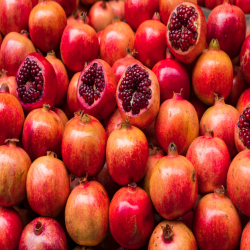Pomegranate Nutrition facts
Pomegranate

Pomegranate is one of the most popular, nutritionally rich fruit known for its unique flavor, taste, and heath-promoting characteristics. Together with sub-arctic pigmented berries and some tropical exotics such as mango, it too has unique qualities of functional foods, often called “super fruits.”
Botanically, it is a small size fruit-bearing deciduous tree belonging to the Lythraceae family, of genus: Punica.
Scientific name: Punica granatum.
Pomegranate tree is thought to have originated in the Persia and Sub-Himalayan foothills of Northern India. It grows about 5 to 8 meters tall. It cultivated at a commercial scale in vast regions across the Indian sub-continent, Iran, Caucuses, and Mediterranean regions for its fruits.
| Nutrition Principle | Nutrition Value | Percentage of RDA |
|---|---|---|
| Principle | ||
| Energy | 83 Kcal | 4% |
| Carbohydrates | 18.70 g | 14% |
| Protein | 1.67 g | 3% |
| Total Fat | 1.17 g | 6% |
| Cholesterol | 0 mg | 0% |
| Dietary Fiber | 4 g | 11% |
| Vitamins | ||
| Folates | 38 µg | 9.5% |
| Niacin | 0.293 mg | 2% |
| Pantothenic acid | 0.135 mg | 3% |
| Pyridoxine | 0.075 mg | 6% |
| Riboflavin | 0.053 mg | 4% |
| Thiamin | 0.067 mg | 5.5% |
| Vitamin A | 0 IU | 0% |
| Vitamin C | 10.2 mg | 17% |
| Vitamin E | 0.60 mg | 4% |
| Vitamin K | 16.4 µg | 14% |
| Electrolytes | ||
| Sodium | 3 mg | 0% |
| Potassium | 236 mg | 5% |
| Minerals | ||
| Calcium | 10 mg | 1% |
| Copper | 0.158 mg | 18% |
| Iron | 0.30 mg | 4% |
| Magnesium | 12 mg | 3% |
| Manganese | 0.119 mg | 5% |
| Phosphorus | 36 mg | 5% |
| Selenium | 0.5 µg | 1% |
| Zinc | 0.35 mg | 3% |
| Phyto-nutrients | ||
| Carotene-α | 0 µg | -- |
| Crypto-xanthin-β | 0 µg | -- |